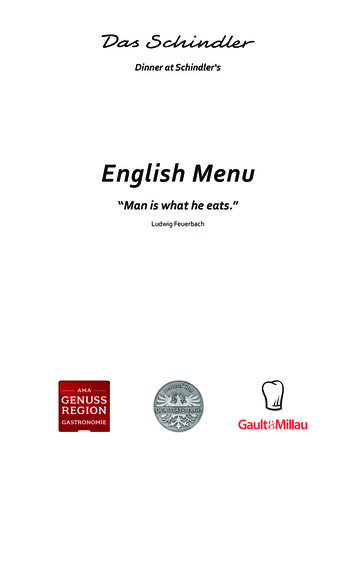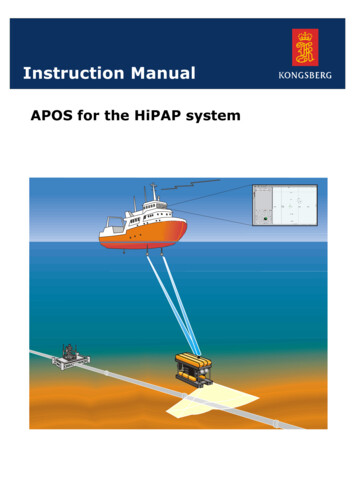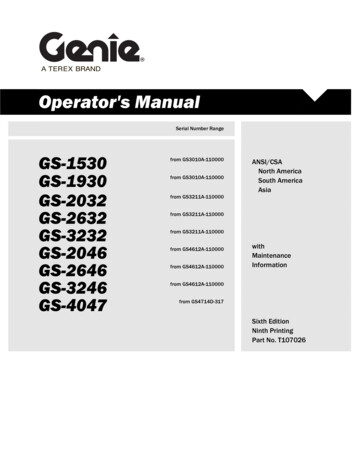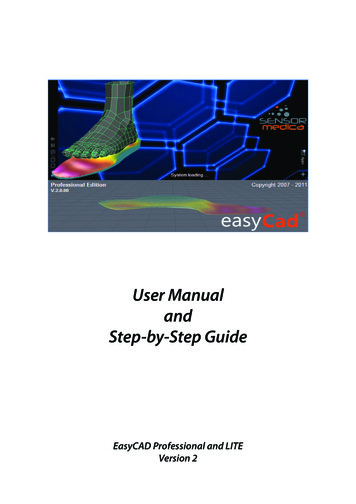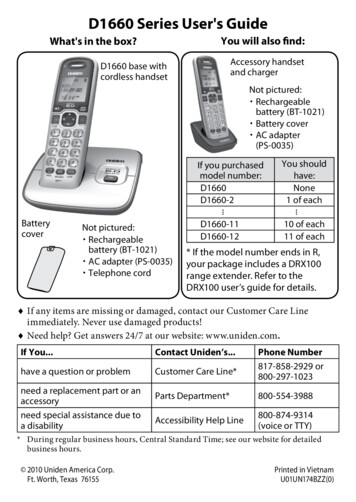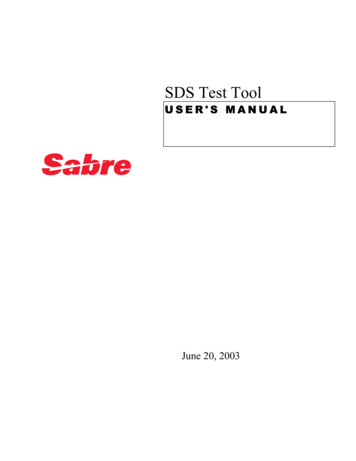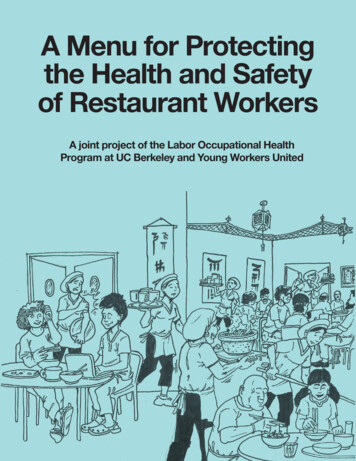
Transcription
A Menu for Protectingthe Health and Safetyof Restaurant WorkersA joint project of the Labor Occupational HealthProgram at UC Berkeley and Young Workers United
A Menu for Protecting the Health and Safety of Restaurant Workers is a jointtraining project of the Labor Occupational Health Program at UC Berkeley andYoung Workers United. If you have any questions, please contact:Labor Occupational Health Program2223 Fulton Street, 4th FloorBerkeley, CA 94720-5120Young Workers United215 Golden Gate AvenueSan Francisco, CA 94102Suzanne Teran(510) 643-2423steran@berkeley.eduTiffany Crain(415) 621-4155youngworkersunited@gmail.comThis training is supported under grant #SH20864SH0 from the Occupational Safety and HealthAdministration, U.S. Department of Labor. It does not necessarily reflect the views or policies of the U.S.Department of Labor, nor does mention of trade names, commercial products, or organizations implyendorsement by the U.S. Government.AcknowledgmentsThese materials have been adapted from other publications, including:Restaurant Safety Training Guide and Protecting the Safety and Health of Restaurant Workers – A Workbook,which were developed as part of the Worker Occupational Safety and Health Training and EducationProgram (WOSHTEP). This Program is administered by the Commission on Health and Safety andWorkers' Compensation in the Department of Industrial Relations through interagency agreements with theLabor Occupational Health Program at the University of California Berkeley, the Labor Occupational Safetyand Health Program at the University of California Los Angeles and the Western Center for AgriculturalHealth and Safety at the University of California Davis.Heat Safety: How to report a problem to Cal/OSHA developed by Cal/OSHA, 2010.
A Menu for Protectingthe Health and Safety ofRestaurant WorkersA joint project of the Labor Occupational Health Program atUC Berkeley and Young Workers UnitedCopyright 2011
Health and safety in restaurantsIn any workplace there are hazards that can cause injuries and illnesses to the people who workthere. This training focuses on restaurants – you will learn more about hazards that are common inrestaurants and how to prevent getting hurt. You will also learn about your rights to a safe workplace.What type of injuriesaffect restaurant workers?The most common injury is sprains andstrains – these make up a third of injuriesreported in restaurants.Other common injuries include cuts,bruises and burns.Most of these injuriesare preventable.The safest restaurant is one in which asmany hazards as possible are eliminatedthrough careful planning and gooddecision-making about how work getsdone. Workers play an important rolein identifying the hazards and makingsuggestions for solutions.Preventing injuries can actually save lives and save money by: reducing workers’ compensation claims; avoiding loss in productivity when injuries occur; and improving employee morale!A Menu for Protecting the Health and Safety of Restaurant Workers1
Health and Safety in RestaurantsLuis’s StoryLuis works at a busy restaurant called “TheHoney Pig.” The dining room seats 180 people.He works at the preparation table cuttingvegetables and meat all day. He has to keep thecutting machine clean.On Monday afternoon, Luis rushed into workfrom his morning job as a school janitor. Hehad to prepare 10 orders of vegetable servingsat once and found that his co-worker from theday shift hadn’t cleaned the vegetable cuttingmachine.Luis tried to quickly clean between themachine’s blades by reaching in with his barehands to pull out some remaining pieces ofvegetables. The machine was not unplugged,and because the turn-on button was verysensitive, he accidentally turned it on. Themachine shredded his three middle fingers.Does this seem familiar? Yes NoWhat causes the injuries of restaurant workers like Luis?2A Menu for Protecting the Health and Safety of Restaurant Workers
Health and Safety in RestaurantsKim’s StoryKim has worked full time as a waitress ata restaurant since she immigrated to theU.S. five years ago.Lately, she becomes tired very easily, getslots of headaches, and feels joint pain andfatigue. The restaurant has been very busyand there is a lot of pressure to work fast.She has tried over the counter medicationto reduce her pain, but the pain on hershoulders, arms, and hands won’t go away.All waitresses at the restaurant have beencomplaining that the trays are too heavy.The manager says that the restaurant istoo busy and that there’s nothing he cando.Does this seem familiar? Yes NoWhat causes the injuries of restaurant workers like Kim?A Menu for Protecting the Health and Safety of Restaurant Workers3
4A Menu for Protecting the Health and Safety of Restaurant Workers
What are Job Hazards?Anything at work with the potential to harm a worker either physically or mentally is considered a jobhazard.Some hazards in restaurants are easily visible. Restaurant workers can see that the hot stove or stonepot can potentially burn their hand or that the ham slicer can potentially cut their fingers. Somehazards are less visible. These are things that can cause workers to be injured or become ill that we donot think of as job hazards. We do not usually think that working too quickly may cause an injury, thatchopping vegetables all day or lifting heavy objects may hurt workers’ wrists and backs over time, orthat using strong cleaning products every day may damage workers’ lungs.Job hazards can be grouped into different categories, such as: Safety hazards which cause immediate accidents and injuries. For example, knives, ovens,slippery floors are hazards that can result in burns, cuts, or broken bones. Ergonomic hazards that cause sprains and strains, such as doing repetitive tasks or heavylifting. Other health hazards: additional workplace conditions that can make you sick, such as noise,chemicals, heat, and stress.Remember, restaurant workers are exposed to many job-related hazards that may cause injuries andillnesses that in turn impact their lives, income, and family members. Restaurant employers also facefinancial challenges in making health and safety improvements and complying with state and federallaws.Restaurant workers and employers can develop skills to identify both the more visible and the lessvisible hazards in the workplace, come up with effective solutions, and communicate about ways toprevent injuries and illnesses.A Menu for Protecting the Health and Safety of Restaurant Workers5
What are job hazards?What is wrong with this picture?6A Menu for Protecting the Health and Safety of Restaurant Workers
Making Restaurants SaferMany hazards exist in restaurants, but there are also steps that can be taken to dramatically improvesafety. As the safety triangle shows there are three main ways to protect workers.The best way to prevent injuries is to remove the hazard altogether (#1), or keep it isolated, away fromworkers, so it can’t hurt anyone. This way the workplace itself is safer!Removing the hazard can sometimes be themost difficult solution, or take the longest timeto implement. You may need other solutions toprotect you in the meantime.1.Removeor isolatethe hazard2. Improve workpractices3. Use protective clothingand equipmentExampleMany restaurant workers get burned lowering frozen food into deep fryers, or cleaning the fryers.What controls can a restaurant put in place to keep workers from getting burned?1. Is there a way to remove the hazard?Install grease pans that dump automatically for cleaning.2. What improvement in work practices would help?Train workers on the importance of shaking ice crystals off frozen foods before putting them into thedeep fryer, to avoid splattering.3. What protective clothing or equipment would help?Gloves, sleevelets, and long aprons. These need to resist heat and grease to at least 400º F for anyoneworking with fryers.A Menu for Protecting the Health and Safety of Restaurant Workers7
Making Restaurants saferWhat solutions do you see in this picture?Remember: The goal should be to come up with changes that remove or isolate the hazards and do notdepend on people to follow procedures that need to be enforced. Procedures can be hard tokeep up when restaurants get busy. Personal protective equipment (PPE) is the last resortbecause it requires proper maintenance and must fit the worker, and it depends on the workerremembering to use it and use it correctly. Many times it takes steps at all levels to protect workers. Once a change has been implemented,it is important to re-evaluate the situation to confirm that the hazard is no longer present orthat other hazards have not been created. Training is necessary to keep workers aware and involved whenever a safety rule will be put inplace or a change will be implemented.8A Menu for Protecting the Health and Safety of Restaurant Workers
making restaurants saferMaking Restaurants Safer WorksheetNow try to come up with a combination of measures to reduce some of the key hazards you identifiedin the hazard mapping activity. Remember that you always aim to remove or isolate the hazard first. Ifthat is not possible, try to come up with a combination of measures to reduce the hazard like improvingwork practices and then using personal protective equipment.HazardsSolutionsRemove or isolate the hazardImprove work practicesProvide personal protective equipmentRemove or isolate the hazardImprove work practicesProvide personal protective equipmentRemove or isolate the hazardImprove work practicesProvide personal protective equipmentA Menu for Protecting the Health and Safety of Restaurant Workers9
10A Menu for Protecting the Health and Safety of Restaurant Workers
Workers’ Rights to a Healthyand Safe WorkplaceBy law, all workers have the right to a safe and healthful workplace. Cal/OSHA is the agency in chargeof making sure that workplaces are safe for all workers. There are specific laws or regulations called“standards” which Cal/OSHA enforces. These laws describe what employers must do to protectworkers and can be divided into three categories:1. Right to know about workplace hazards2. Right to protection from these hazards3. Right to act to improve workplace safetyA Menu for Protecting the Health and Safety of Restaurant Workers11
Workers’ rights to a healthy workplace1. Right to know about workplace hazardsThe Hazard CommunicationStandardThis standard gives you the right to know aboutthe chemicals you work with and requires thatemployers: Make an inventory of all the chemicals used orstored at the workplace. Label all chemical products. Obtain and make available to employees copiesof the Material Safety Data Sheets (MSDSs)for all chemicals. MSDSs give you detailedinformation about the chemical, possible healtheffects, and how to work with it safely. Train all employees about the chemicals theywork with and how to use them safely.Do you want to know: How dangerous is this chemical? How can this product affect my health? What other chemicals are used in myworkplace?Recording and Reporting of Occupational Injuries and IllnessesCal/OSHA Form 300Every employer with ten or more employees mustrecord most occupational injuries and illnesses ona state form called the Cal/OSHA Form 300. Anemployer must record any job injury that requiresmore than first aid treatment or that results in lostwork time, restricted duties or transfer to another job,or where the worker loses consciousness. All workrelated illnesses must be recorded.An annual summary of the Form 300 must be postedin the workplace for three months, from February 1to April 30 each year.Workers have a right to get a copy of the Form300 and the Annual Summary.12Do you want to know: What type of injuries have occurred inyour workplace? How many workers were injured in thelast year?A Menu for Protecting the Health and Safety of Restaurant Workers
Workers’ rights to a healthy workplace2. Right to protection from workplace hazardsInjury and Illness Prevention Program (IIPP)This standard requires every California employer to havean effective Injury and Illness Prevention Program (IIPP)to promote health and safety in the workplace. The IIPPmust include the following information:1. Name of the person responsible for the program.Do you want to: Give suggestions for improvingsafety at your workplace? Receive training in the languageyou speak?2. A system for making sure workers comply with safety rules and procedures.3. A system to communicate with workers on health and safety matters, which must include away for workers to report unsafe conditions without fear of reprisal.4. A system to identify unsafe or unhealthful conditions. This must include regular inspectionsof the worksite. Supervisors must be informed of any problems found.5. A system to investigate any job-related injuries and illnesses that occur.6. A system to correct hazards in a timely manner.7. Training for workers about the specific hazards on their jobs before they start work and everytime a new hazard is introduced. Training must provided in a language and manner workerscan understand.8. A written document describing the IIPP. Workplaces with fewer than 10 employees areexempt from some documentation requirements.A Menu for Protecting the Health and Safety of Restaurant Workers13
Workers’ rights to a healthy workplace3. Right to Act to improve workplace safetyRight to Report a Problem to Cal/OSHAYou have a right to make a complaint to Cal/OSHA, theagency in charge of making sure that workplaces are safefor all workers. Cal/OSHA will investigate if you and otherworkers are in danger of work-related injury or death. Theywill not ask you about your immigration status.You can contact Cal/OSHA directly, or a communityorganization can assist you. Community organizationsinclude unions, worker centers, churches and other localgroups. It is illegal for your employer to fire or punish youfor reporting or making a complaint about unsafe workingconditions.Are you concerned abouta hazard that has never been fixed, andwonder where you can go for help?Cal/OSHA will respond more rapidly if you provide the following information:1. The name of your employer or company and the kind of work you are doing.2. Where the job is located – this is important so Cal/OSHA can find your worksite.3. The problem – Give as many details as you can about the problem and how it affects youand other workers.4. The number of workers at the site and what languages they speak.5. The hours of work and how long the work will continue at that location (another day, week ormonth?)6. Your name – Cal/OSHA will not tell your employer who called. You are not required to giveyour name if you do not want to.How can you report a problem to Cal/OSHA?Call, fax a complaint and/or go in person to your local Cal/OSHA office.Find your local office: Call 1-866-924-9757 (enter your zip code to find the closest office) Go to http://www.dir.ca.gov/dosh/DistrictOffices.htmFind a complaint form online: English version: http://www.dir.ca.gov/dosh/WebComplaintForm.pdf Spanish version: 4A Menu for Protecting the Health and Safety of Restaurant Workers
Workers’ rights to a healthy workplaceRight to Act to improve workplace safety(continued)What will Cal/OSHA do?Cal/OSHA inspectors will come to a worksite if they believe the employer is violating worker healthand safety standards or workers are in danger of injury or death.They will ask the employer and workers questions to find out more about the hazards. You have a rightto talk with the inspector in private. Get the inspector’s phone number if you prefer to talk when youare not at work. Tell the inspector about any problems and any changes that are needed to protect your health –you are the expert about conditions at your job. If the inspector doesn’t speak your language, heor she will request an interpretation service. If it is determined that the employer has violated a safety standard, Cal/OSHA will give acitation and fine to the employer. The employer must fix the problem by a specific date.Right to Refuse Unsafe WorkIf you are ever asked to do job tasks that you believe might lead to death or serious injury, you canand should refuse to do that work. Ideally, your workplace will have a safety system to make sure thatworkers are never called on to perform an unsafe act. If you do refuse to do a dangerous task, Cal/OSHA protects you against punishment but only if certain conditions are met: Doing the work could expose you to a “real and apparent” hazard that could result in injury ordeath. You first ask the employer or supervisor to eliminate the hazard. There is not enough time to correct the problem through normal Cal/OSHA enforcementprocedures. You inform the employer that you are willing to perform other work until the hazard iseliminated.If all these conditions are met and workers are punished for refusing to do work they believe isespecially dangerous, you can file a complaint with the state Labor Commissioner.A Menu for Protecting the Health and Safety of Restaurant Workers15
Workers’ rights to a healthy workplaceOther rightsIn addition to the health and safety rights already described, workers have the right to: At least the California minimum wage, 8 per hour. A half-hour unpaid meal period after no more than 5 hours of work, and a 10-minute paid restperiod after each 4 hours of work. Work without racial or sexual harassment. Join or organize a union.In San Francisco, workers have the right to: A minimum wage of 9.92. Sick leave – Workers have a right to one hour of paid sick leave for every 30 hours worked, witha cap or maximum of 72 hours. For small businesses with less than ten employees, the cap is 40hours. Health plan benefits, if you work for an employer with 20 or more employees.16A Menu for Protecting the Health and Safety of Restaurant Workers
Workers’ rights to a healthy workplaceWorkers’ compensation if injured on the jobEvery workplace should have a plan for handling injuries. Employees need to know when and how toreport injuries.Should these restaurant workers report their injury to their supervisor?A. Carlos cut his hand with the knife while choppingvegetables. He needs stitches and a tetanus shot.B. Sara’s arms ache during her shift as a server. Onsome days, she can barely carry the trays.Both of these injuries should be reported to the supervisor. If you get hurt on the job, youremployer is required by law to pay for workers’ compensation benefits. These benefits can include: Medical Care. Paid for by your employer, to help you recover from an injury or illness causedby work. Temporary Disability Benefits. Payments if you lose wages because your injury prevents youfrom doing your usual job while recovering. Permanent Disability Benefits. Payments if you don’t recover completely. Supplemental Job Displacement Benefit. If you need to change jobs, this provides a voucherto help pay for retraining or skill enhancement if you don’t recover completely, your employerdoesn’t offer you work, and you don’t return to work for your employer. Death Benefits. Payments to your spouse, children or other dependents if you die from a jobinjury or illness.You don’t have to be a legal resident of the United States to receive most workers’ compensationbenefits.A Menu for Protecting the Health and Safety of Restaurant Workers17
Workers’ rights to a healthy workplaceHow does the law help these workers?Roberto’s storyIn the last three months, workers at Joe’s Big Steak have started using a new dishwashing liquid. Acouple of workers have developed rashes and Roberto often feels headaches after using it. He also feelslike his hands burn. He isn’t sure if it’s due to the new dishwashing liquid, and wonders if he should bewearing gloves or doing something to protect himself. None of the workers received training on thisproduct or other chemicals they use.(Look at the Hazard Communication Standard on page 12 to answer these questions.)1. What is the problem?2. How does the Hazard Communication Standard help workers like Roberto?3. What are two main points that you think are most helpful about this standard?18A Menu for Protecting the Health and Safety of Restaurant Workers
Workers’ rights to a healthy workplaceAna’s storyAna has worked at Taqueria La Mejor for two years. She has received several trainings on handlingfood safely, but doesn’t remember ever receiving training on her own safety at work. Accidents havebeen common at the taqueria. Co-workers have been burned by hot oil and slipped on wet floors, andseveral are having back problems. She has some good ideas for making the restaurant safer, but doesn’tknow if she could talk to the manager without getting in trouble.(Look at the Injury and Illness Prevention Program on page 13 to answer these questions.)1. What is the problem?2. How does the Injury and Illness Prevention Program (IIPP) help workers like Ana?3. What are two main points that you think are most helpful about the IIPP?A Menu for Protecting the Health and Safety of Restaurant Workers19
Workers’ rights to a healthy workplaceJulia’s StorySeveral workers at The Golden Restaurant, the restaurant where Julia works, have suffered burnsfrom the hot oil that splashes from the deep fryer. Even though Julia knows that you always have todefrost the food before putting it into the fryer, she sees how new workers arrive and nobody trainsthem. There is just no time. The restaurant is so busy and the managers push them to work morequickly. The manager tells them they should all be happy to have a job, and Julia doesn’t dare sayanything about the fryer.(Look at the Right to Report a Problem to Cal/OSHA on page 14 to answer these questions.)1. What is the problem?2. How does the Right to Report a Problem to Cal/OSHA help workers like Julia?3. What are two main points that you think are most helpful about this right?20A Menu for Protecting the Health and Safety of Restaurant Workers
Taking it back to workResources to improve safety at your restaurantThis section contains resources that you can use to improve safety at your restaurant. These include: Restaurant Hazard Checklist – use it during a walk-through to help identify key hazards. (page 24) Five Tip Sheets that give you ideas for dealing with specific hazards. These tip sheets includesuggestions for what management can do to make the workplace safer, and suggestions for workersto follow safe work practices and use protective clothing as needed.Topics addressed are: Burns and Hot Stuff (page 24) Cuts and Sharp Stuff (page 26) Slips and Falls (page 28) Ergonomics Hazards(page 30) Robberies and Assaults (page 32) Two tip sheets to address: Emergencies and how to be prepared (page 34) Injuries on the job (page 35)A Menu for Protecting the Health and Safety of Restaurant Workers21
Taking it back to workNext StepsRestaurant workers and employers need to work together to prevent injuries and illnesses andimprove productivity and the overall functioning of their workplace. Workers are in an importantposition to identify hazards and to suggest solutions. Managers may provide the resources andhave the decision-making power to implement the changes that will keep workers from beinginjured or becoming ill. The following are things restaurant workers and their employers can do toprotect everyone’s health:What can workers do? Report hazards and injuries to their manager or employer immediately. Practice using the hazards checklist and hazard mapping. Suggest the best solutions to the hazards present in their workplace. Participate in safety and health training.What can workers ask management to do? Set up safety meetings to listen to workers’ concerns. Set up and support a safety committee that would take on the task of identifying hazards andcoming up with solutions. Provide health and safety training for all workers.Key points to remember: A job hazard is anything that can potentially harm workers physically or mentally. Some job hazards are more obvious because we know they are dangerous, and some are not,such as things that can harm workers over a longer period. Workers are in an important position to identify hazards and to suggest solutions. Managersmay provide the resources and have the decision-making power to implement the changes thatwill keep workers from being injured or becoming ill.22A Menu for Protecting the Health and Safety of Restaurant Workers
Taking it back to workRestaurant Hazards Checklist1. Check all the hazards below that you believe you have in your restaurant. This checklist doesn’tcover every hazard, but will help you think about the most common ones. Use the blank linesto add any hazards that you think are important but are not listed.2. Decide which three you think are the most serious hazards. Circle them.3. Look at the tip sheets on pages 24-36 for ideas for dealing with these hazards.Hot Stuff Ovens and broilers Grills and stovetops Deep fryers Microwave ovens Coffee makers Sharp Stuff Knives Power slicers/grinders Food processors Broken glass Box cutters / tools Slips and Falls Slippery floors Clutter on floors Cluttered exits Cords Climbing to reach things Ergonomic Hazards Awkward lifting Heavy lifting Awkward bending or reaching Repetitive movements Standing for long periods Robberies and Assaults Working alone Working late at night Handling large amounts of cash Poor visibility from street No alarm system Chemicals Dishwashing products Cleaning products Pesticides Other Hazards A Menu for Protecting the Health and Safety of Restaurant Workers23
Taking it back to workPreventing Burns from Hot StuffStove Tops, Ovens, Broilers, GrillsMake the Workplace Safer Provide grills and other hot surfaces that have built-in guardbars, so workers won’t accidentally touch them.Follow Safe Work Practices Avoid overcrowding on the range tops. Set pot handles away from burners, and make sure theydon’t stick out over the edge of the range.DID YOU KNOW?Workers under 16 are notallowed to bake, and they canonly do light cooking withelectric or gas grills that do notinvolve cooking on an openflame. Adjust burner flames to cover only the bottom of a pan. Don’t fill pots too full, to avoid boiling over. Lift pot covers back safely to protect yourself from steam. Use tongs to lower food into boiling water. Get help when moving or carrying a heavy pot of simmering liquid. Never leave hot oil or grease unattended.Use Protective Clothing and Equipment Use potholders, gloves, or mitts when checking food on the stove, placing food in boilingwater, or reaching into ovens and broilers. Never use wet material (like a damp towel) as a potholder.Deep FryersMake the Workplace Safer Provide fryers that dump usedgrease automatically. Provide fryers that lower food automatically intothe hot oil. Use splash guards on fryers.Follow Safe Work Practices Dry off wet food and brush off ice crystals beforeplacing the food in the fryer basket. Wet foodssplatter and cause steam.24A Menu for Protecting the Health and Safety of Restaurant Workers
Taking it back to work Fill fryer baskets no more than half full. Raise and lower fryer baskets gently. Do not stand too close to hot oil, or lean over it. Keep beverages and other liquids away from fryers. Don’t strain hot oil or carry it. Wait until it is cool. Follow directions when adding new fat or oil. Cover fryer oil when it’s not in use.Use Protective Clothing and Equipment Use potholders, gloves, or mitts. Never use wet material (like a damp towel) as a potholder.Microwave OvensMake the Workplace Safer Provide ovens that turn off when the door is opened. Check seals on microwave oven doors periodically.Follow Safe Work Practices Do not use metal containers, foil, or utensils in a microwave oven. Open containers carefully after removing them from the microwave, to allowsteam to escape.Use Protective Clothing and Equipment Use hot pads, potholders, gloves, or mitts when removing items from the microwave.For More InformationWorkers can also be burned when they slip or trip. They may fall against or touch a hot surface.Look at Tip Sheet: Preventing Injuries from Slips and Falls.A Menu for Protecting the Health and Safety of Restaurant Workers25
Taking it back to workPreventing Cuts from Sharp StuffKnivesMake the Workplace Safer Provide knives that are the right size and type for eachjob. Provide box cutters for opening boxes. Provide proper storage for knives (counter racks, wallracks,or storage blocks).DID YOU KNOW?Workers under 18 are notallowed to use, clean, takeapart, or assemble largeelectrical appliances, such asautomatic slicers and bakerymachines. Allow workers enough time to work safely.Follow Safe Work Practices Keep knives sharp. Dull knives are unsafe. Never leave knives soaking in water. Place a damp cloth under your cutting board to keep it from slipping. If you are interrupted while cutting, put the knife down in a flat, safe place. Pass a knife to another person by laying it on a counter, or pass with blade pointed down. Let a falling knife fall. Step back. Warn others. Never try to catch the knife. Carry and store knives in sheaths or protective cases when possible. When cutting, tuck in fingers on the hand that’s holding the food.Use Protective Clothing and Equipment If you’re doing a lot of cutting, wear cut-resistantgloves that cover the wrists, fit well, and havesturdy, tightly-woven seams.26A Menu for
fatigue. The restaurant has been very busy and there is a lot of pressure to work fast. She has tried over the counter medication to reduce her pain, but the pain on her shoulders, arms, and hands won’t go away. All waitresses at the restaurant have been complaining that the trays are too heavy. The mana




